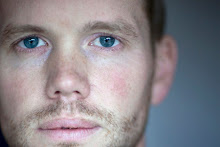Friday, April 16, 2010
A rehearsal with James Beckett
The forms explored by Ashley -which often include only a restricted number of elements that are inserted into structures where repetition is very important- certainly provide some inspiration for James. On a different level, however, his usage of found objects is probably more closely related to world of contemporary visual arts or to the theatrical work of directors such as Tadeusz Kantor (as I have pointed out in a previous post.) From a collection of unusual relics found in abandoned Polish factories, he has devised a space that offers a glimpse into the life inside those factories. It is not a collection of stories or a historical explanation of what happened there, but rather an artistic interpretation, carefully crafted by the combination of concrete objects and rhythmic sequences of voices and movements, that are both compelling and mysterious.
Tuesday, April 6, 2010
A second rehearsal with Roos van Geffen.
The interesting thing is that these emotions are completely in the mind of the spectator (in this case, in my mind). The performers are actually forbidden to try to represent or act out any emotion. Rather, they give themselves completely to the task of following a very precise set of actions, rigorously woven together. When they accomplish this scheme with full concentration, then the audience members can engage with them in a playful and active usage of their imagination, bringing along their own set of associations. Roos describes her objective as “triggering deeper layers of memory” in the minds of the spectators. During the rehearsal I couldn't help thinking about the beautiful book by Yoshi Oida, An actor adrift. There, he often describes how some of the most striking performances he ever witnessed were always accomplished by actors whose mind was “empty”. Empty, at least, of emotions. He explains how, when a complete devotion to a physical task is accomplished by a performer on stage, a state of perfect blankness is achieved, a void which can be compared to a hollow container, which the spectators -in a way which is often unconscious- fill in with their own minds, with imagery from their personal memories.


